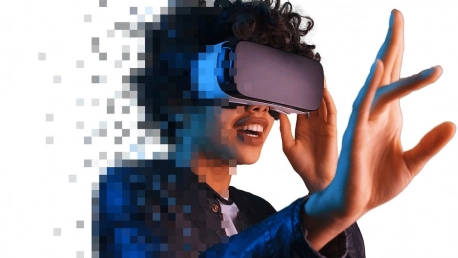Augmented Reality (AR) technology is set to revolutionize the retail landscape, significantly enhancing customer experiences. Forecasters anticipate that by 2030, AR could propel the retail market to a stunning valuation of $100 billion. The reason behind this surge is AR’s ability to craft vivid, interactive shopping scenarios that not only captivate consumers but also have the potential to transform traditional retail practices. This immersive tech isn’t just a gimmick; it’s quickly becoming a cornerstone strategy for retailers, intent on connecting with their customers in more meaningful ways. With AR, shoppers can visualize products in their own space before purchasing, receive personalized recommendations, and enjoy a more engaging retail journey. As retailers continue to adopt AR, we’re witnessing the beginning of a significant shift in how consumers browse, interact with, and buy products – a change that could redefine the commercial landscape for decades to come.
The Advent of AR in Retail
Augmented Reality: A Market Overview
The AR market is witnessing significant growth, with its value reaching roughly $22 billion in 2022 and expected to surge at a 21% compound annual growth rate to 2030. This vibrant expansion highlights the technology’s increasing influence, particularly within the retail sector. Retailers are constantly seeking innovative ways to engage consumers, and AR offers an unparalleled opportunity to merge the online and physical shopping experiences in a transformative manner. As consumer behavior evolves and the demand for immersive shopping experiences grows, AR proves to be a potent tool for retailers. Through AR, customers can visualize products in their own space before purchasing, try on clothes virtually, or even navigate stores more effectively. This integration of AR into retail doesn’t just enhance consumer convenience; it represents a critical evolution of the shopping journey.With the potential to reshape brand interactions and customer engagement, AR technology is progressively moving from an optional enhancement to a core component of retail strategy. This trend is indicative of how retailers are leveraging cutting-edge technology to stay relevant and competitive in a rapidly changing market landscape. The projected growth of AR demonstrates its vital role in the future of retail, where the boundaries between the digital and physical realms continue to blur.
Driving Forces Behind AR Adoption
In today’s market, consumers are on the hunt for shopping experiences that are not only captivating but also user-friendly. Augmented Reality (AR) hits the mark by providing unique, customized, and engaging shopping journeys. As retailers aim to stay ahead, they’re incorporating AR to revolutionize their retail environments, merging the physical with the digital in a way that feels effortless and exciting for customers.This innovative technology transforms traditional shopping into interactive adventures, allowing consumers to visualize products in their own space, try on clothes virtually, or see how a piece of furniture would fit in their homes before making a purchase. Such personalized interactions lead to higher engagement rates and increased sales, as shoppers are more likely to buy when they’ve had an immersive experience.Retailers who adopt AR are creating immersive worlds within their stores and online platforms, making shopping an entertaining and dynamic activity. By doing so, they craft a competitive edge in the retail industry, enticing customers with a futuristic blend of in-store and online shopping that feels tailor-made.Enhanced with AR, the shopping experience breaks free from the constraints of physical space, offering endless possibilities for customization and exploration. As consumers engage with AR-enabled experiences, they enjoy a seamless blend of reality and technology which, in turn, fosters brand loyalty and boosts revenue. Thus, AR is fast becoming an indispensable tool for retailers striving to meet and exceed the modern shopper’s expectations.
Key Players and Innovators
Tech Giants Spearheading AR Development
In the quest to pioneer augmented reality (AR), industry behemoths like Apple, Amazon, and Alphabet’s Google stand out with robust platforms and AR development tools. These tech giants are paving the way for future AR applications by integrating their technologies into our everyday digital experiences. Their efforts are critical in making AR more accessible and useful for consumers and developers alike.Simultaneously, niche AR companies such as Magic Leap and Vuzix are making a significant impact in the retail sector by introducing innovative AR-driven retail strategies. These strategies are revolutionizing the way consumers shop by enabling them to visualize products in a real-world context before making a purchase, thus transforming the traditional shopping experience into one that is immersive and interactive.Such AR solutions by specialized firms are not just transforming the retail industry but are also raising the bar for the application of immersive technology in shopping. This is not only enhancing the retail experience for consumers but is also benefiting retailers by providing them with new ways to engage with customers, personalize shopping experiences, and ultimately drive sales.Overall, the combination of tech giants providing foundational AR technologies and specialized firms focusing on sector-specific applications, such as retail, is fostering a dynamic ecosystem for AR. This is setting new industry standards and is likely to continue shaping how we experience shopping and other aspects of our digital lives.
Retail and Apparel Embracing AR Technology
Major players in retail and fashion such as Nike and L’Oréal are at the forefront of integrating augmented reality (AR) to revolutionize the shopping experience. Nike’s utilization of virtual fitting rooms allows customers to try on footwear digitally, while L’Oréal’s AR-powered trials enable shoppers to test makeup without physical application. These innovations are not just enhancing customer interaction and satisfaction, but are also setting new standards in retail technology.This push towards AR has also paved the way for innovative startups to enter the market, bringing new ideas that further alter how consumers shop and engage with brands. These new companies are instrumental in driving the evolution of customer expectations, as they offer unique experiences that were previously unavailable. Through AR, shoppers can now enjoy a more interactive and personalized shopping experience, getting a better sense of how a product will look or fit without being physically present in a store.The impact of these advancements is significant as more brands invest in AR to stay competitive and relevant in an increasingly digital marketplace. As a result, what may have once been considered a novel or niche application of technology is rapidly becoming an essential component of modern retail strategies, enhancing the way products are presented and sold. The influence of AR in retail marks a pivotal shift in the industry, bridging the gap between the physical and digital worlds and redefining the shopping journey.
AR Integration Across the Shopping Experience
Augmenting the In-Store Journey
Augmented Reality (AR) is transforming the traditional shopping experience in physical stores by introducing an array of engaging and interactive elements. As customers step into these revitalized retail spaces, they encounter dynamic displays that respond to their presence and provide tailored information, vastly improving the shopping journey. AR technology also introduces novel ways to navigate stores, guiding customers effortlessly to their desired products.Moreover, immersive advertising campaigns crafted through the capabilities of AR are capturing customer attention in ways previously unimaginable. Shoppers find themselves interacting with products and brand narratives within a captivating, virtual overlay, making their shopping experience not only informative but also entertaining. This heightened level of engagement not only draws more people into stores but also has the potential to influence their spending habits positively.The innovative use of AR in brick-and-mortar venues does more than merely enhance the aesthetic appeal or entertainment value; it offers a compelling reason for customers to visit physical stores in an age where online shopping is prevalent. By merging digital interactivity with the tangible aspects of traditional shopping, retailers provide a unique and memorable experience that encourages visitors not just to stay longer, but also to return. Thus, implementing AR is a strategic move that can lead to increased customer loyalty and potentially higher sales for the retail industry.
Virtual Try-Ons and Online Interaction
The retail landscape is undergoing a transformation with the advent of virtual try-ons and the integration of augmented reality (AR) into online shopping platforms. As these technologically advanced tools become commonplace, they promise to reduce return rates by enhancing customers’ ability to make well-informed choices. Virtual try-on technology allows shoppers to see themselves with products, such as glasses or clothing, before making a purchase, thereby increasing confidence in their buying decisions.Augmented reality further enriches the shopping experience by enabling a more interactive and immersive interface. Shoppers can see how furniture might look in their living room or how a shade of makeup would appear on their skin, all from the comfort of their home. This practical application of AR is critical in reducing the uncertainty that often accompanies online shopping, especially for products that have traditionally been selected in-store.By integrating these digital innovations, retailers are effectively narrowing the division between online and brick-and-mortar shops, crafting a more seamless and unified retail experience. The growth of virtual and AR-enhanced shopping not only caters to modern consumers’ desire for convenience and immediacy but also benefits retailers by potentially decreasing the costs associated with returns. As technology continues to evolve, it is clear that the future of retail will be characterized by a blending of the digital and physical worlds, offering consumers a personalized, efficient, and engaging way to shop.
The Economic Impact of AR on Retail
Potentials for Market Expansion
The transformative effect of Augmented Reality (AR) on the retail sector is evident through detailed case studies. These studies reveal that AR isn’t just a novelty; it’s a powerful tool for boosting sales and enhancing the consumer experience. As stores adopt AR, they’re not just altering how we shop—they’re expanding what’s possible within retail.For instance, IKEA’s AR app allows customers to visualize furniture in their own homes before making a purchase. This practical use of AR has led to increased customer satisfaction and a corresponding surge in sales. Similarly, beauty brands like Sephora use AR to let customers try on makeup virtually, leading to more confident and satisfied purchasers.As AR gets woven into the fabric of retail, shopping becomes an immersive adventure. Customers can explore products in high detail without ever touching them physically, receive personalized suggestions, and make more informed choices. These enhancements pave the way for a future where digital and physical retail are deeply integrated, offering shoppers unparalleled convenience and retailers new growth opportunities.Retailers who invest in AR go beyond the traditional storefront, breaking into a market ripe with potential. They create paths to memorable and engaging customer journeys that could have deep implications not just for sales figures but for the evolution of retail itself.
Value Chain Analysis of AR Contributions
The augmented reality (AR) value chain is a complex mosaic of interlocking components that make up its hardware, software, and service layers. Each segment within this chain plays a pivotal role in advancing and maintaining the innovation that AR brings to the retail industry. When we dissect the AR landscape, it’s clear that there are critical players, from the designers of the headsets and the programmers of the software to the strategists that implement AR solutions within the retail environment, all coming together to amplify the technology’s utility and ensure its future progression.This network of contributors is what turns AR from a mere concept into a tangible asset for the retail sector. Through their collaborative efforts, they drive forward the technology, making it not only more imaginative in its applications but also increasingly accessible and feasible for wide adoption. This synergy among hardware manufacturers, software developers, and retail experts is crucial to refining AR’s precision and enhancing the consumer experience in a retail context, thereby making AR not only an engaging novelty but also a staple in the transformative digital shopping experience. As they each contribute their expertise and resources, they are positioning AR as a versatile tool that can scale across the industry, ensuring that its benefits can be harnessed to reshape shopping into an immersive and interactive journey.
Future Outlook: AR as a Necessity in Retail
Meeting Consumer Demand Through AR
Augmented Reality (AR) technology has progressed beyond its origins as an enticing novelty to now serve as a crucial pillar in the retail industry’s strategies. This advancement aligns with a modern consumer base that increasingly values personalized shopping experiences and the ease that digital tools can provide. In an evolving marketplace where staying relevant is key, the incorporation of AR into retail operations is not merely an option but a strategic necessity.AR’s practical applications in retail range from virtual try-ons to in-store navigation, offering a blend of convenience and personalized interaction that customers now expect. Such features enhance the consumer’s decision-making process and encourage engagement by providing an immersive, interactive shopping experience. Furthermore, AR brings a level of data-driven personalization that was previously unattainable, allowing for tailor-made recommendations and adjustments to individual preferences, which significantly boosts customer satisfaction and loyalty.Retailers are acknowledging that AR’s potential goes well beyond gimmickry. Its utility in creating compelling and convenient shopping journeys is becoming an indispensable component of competitive retail strategy. As it stands, AR’s transformation from an extraordinary tech showcase to a standard consumer expectation underscores its importance in the adaptation of retailers to the demands of a tech-savvy marketplace. It represents a significant step in the digital transformation journey that retailers are navigating to maintain resonance with shifting consumer desires and behaviors.
The Ripple Effect of AR on Industry Trends
The integration of Augmented Reality (AR) technology is rapidly expanding beyond the retail sector, showcasing a significant shift towards immersive digital experiences in various industries. As such technologies become increasingly mainstream, they are setting new standards for consumer engagement and interaction, highlighting the necessity for businesses across sectors to embrace these advancements.Retailers, in particular, must leverage AR to captivate the modern, technology-driven shopper who expects interactive and enhanced shopping experiences. By integrating AR solutions, retailers are able to offer customers the opportunity to visualize products in a realistic context, aiding their decision-making process and providing a unique and personal connection that conventional online shopping lacks.Furthermore, the implementation of AR is not just about meeting current consumer demands. It serves as a critical strategy in future-proofing businesses. The competitive nature of the market, along with rapid technological innovation, means that companies who fail to adapt risk falling behind. As AR technology continues to evolve and become more accessible, it is likely that it will play an increasingly pivotal role in the customer journey.Therefore, it’s vital for retailers and other industries to invest in AR to maintain relevance and a competitive edge. It’s not simply a trend but an evolution in how businesses interact with their customers. From virtual try-ons to augmented product manuals, the possibilities are extensive. Companies that harness the power of AR can expect to provide more engaging and memorable consumer experiences, whilst also positioning themselves at the forefront of a tech-empowered business landscape.









